| Back Number | No.02 2004/11/10 | |||
| News | EXPO 2005 Media Center Opens |  |
||
| Pavilions : Toyota Group Pavilion | ||||
| Interview | Evgeny Velikhov (Russia) President of the Russian Research Center Kurchatov Institute; Chairman of the Board, International Program (Russia, USA, EU and Japan), Development of Thermonuclear Pilot Reactor; member of the Concept Committee for Russian Participation |
|||
| Column | Global Commons | |||
![]()
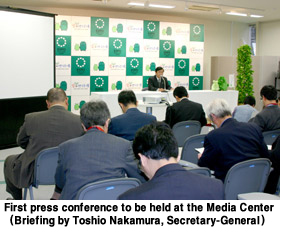 The EXPO 2005 Media Center opened last month on October 26 on the second floor of the West Administration Block below Global Common 5 at the Nagakute Area venue.
The EXPO 2005 Media Center opened last month on October 26 on the second floor of the West Administration Block below Global Common 5 at the Nagakute Area venue.Until March 14 next year, services at this base for disseminating news about EXPO 2005 will be available between 9:00am and 5:30pm. Service hours will be extended to 8:00am to 11:00pm from March 15, ten days before the opening of this world exposition, through September 25, 2005 when EXPO 2005 will come to a close. The Media Center’s common-use press room will be open to accredited members of the press with media passes. The press room will consist of a work area that will seat about 50 people. Copy machines (B&W) and online personal computers will be available for use. Fax machines and public phones will also be installed. Press conferences and briefings by organizers, in addition to press conferences by countries and pavilions exhibiting at EXPO 2005, will be conducted on a regular basis at the Media Center in the common-use press conference room. The press conference room will be fully equipped with 80 chairs (with writing surfaces attached) as well as pedestals for cameras and simultaneous interpretation booths. Accredited members of the press will have access to an exclusive website that will provide the latest information about press coverage and press conferences, etc. at EXPO 2005. Meanwhile, press releases can be picked up as needed at the Media Center. Press kits (in Japanese and English) as well as brochures (pamphlets of EXPO 2005, etc.) will also be available. Other services that can be used by those with press passes include a cafeteria, convenience store, dry cleaning, post office and bank. Details regarding media accreditation and passes are as follows:
|
![]()
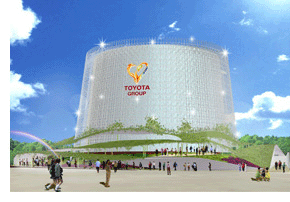 Ever since the Toyota Motor Corporation was founded in 1937, the headquarters of this world-leading manufacturer of automobiles has been located in Aichi Prefecture, the venue of EXPO 2005 Aichi, Japan. At EXPO 2005, the Toyota Group, which consists of Toyota Motor Corporation and 16 other group companies, will be establishing the Toyota Group Pavilion with the exhibit theme of “The Dream, Joy and Inspiration of Mobility in the 21st Century.”
Ever since the Toyota Motor Corporation was founded in 1937, the headquarters of this world-leading manufacturer of automobiles has been located in Aichi Prefecture, the venue of EXPO 2005 Aichi, Japan. At EXPO 2005, the Toyota Group, which consists of Toyota Motor Corporation and 16 other group companies, will be establishing the Toyota Group Pavilion with the exhibit theme of “The Dream, Joy and Inspiration of Mobility in the 21st Century.”Currently under development for EXPO 2005 is the “i-unit” concept vehicle, a futuristic single-passenger vehicle. The i-unit provides dream-like mobility. Various features that will be sought in cars of the future are scheduled to be introduced at the EXPO. It includes systems for the realization of a society without accidents or traffic jams, such as collision-avoidance system and formation driving of i-unit. Another highlight of the pavilion is Toyota Partner Robots. A range of robots, such as robots that play a trumpet using delicate lip movement and a diverse range of hand movement, are scheduled to appear at the pavilion. Other robots under development by Toyota Motor Corporation include those that have applications in fields such as personal assistance, welfare services, manufacturing and mobility. |
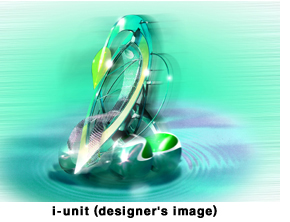 Visitors can look forward to seeing the Performance Show, a two-part stage attraction featuring the i-unit and Toyota Partner Robots. It starts with the Welcome Show in which robots greet visitors through a joyful opening piece. The Main Show is a spectacle brought about through a performance by i-units, robots and human performers, along with a large 360-degree screen that surrounds the audience, and stage equipment. The life, nature and aspects of future life shown on stage will provide a chance for visitors to take a look at the wonders of living and moving freely as well as introduce a new relationship between people and vehicles. Under the basic concept Natural-Cycle Earth Pavilion, care has been taken to integrate various innovations into the pavilion. The building itself was constructed with dismantling and reuse as a given. The utilization of recyclable and renewable materials has been executed, such as exterior walls constructed of used paper and recycled paper. Furthermore, reuse and recycle will be thoroughly implemented upon dismantling. The aim is to leave no construction waste behind. On top of this, an offsite wind power generator is scheduled to produce an equivalent amount of electricity as that consumed in the operation of the pavilion. |
![]()
![]()
 |
|
|
|
|
![]()
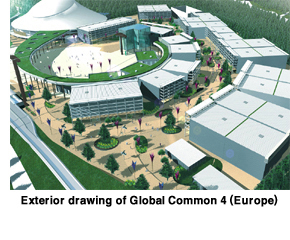 In a hilly area surrounded by nature at EXPO 2005 Aichi, Japan’s Nagakute Area will be six Global Commons, with each Global Common shared by regions such as Asia; North, Central and South America; the Mediterranean; Europe; Africa; and South East Asia and Oceania. The Global Commons is connected and united as one through the Global Loop elevated corridor.
In a hilly area surrounded by nature at EXPO 2005 Aichi, Japan’s Nagakute Area will be six Global Commons, with each Global Common shared by regions such as Asia; North, Central and South America; the Mediterranean; Europe; Africa; and South East Asia and Oceania. The Global Commons is connected and united as one through the Global Loop elevated corridor.The Global Commons was born out of the Grand Intercultural Symphony concept that represents a world in which humanity, with its diverse cultures and civilizations, share one place, coexist, and interact in peace. The pavilions of participating countries will be established within the Global Commons. Here, visitors will be able to encounter people from more than 120 countries and international organizations around the world. They will be able to see, hear, and experience the diverse culture of each country directly through the events and exhibits designed through the wisdom and ingenuity of the people of each participating country. Ingenuity has also been applied to the construction of the pavilions within the Global Commons. Exhibition facilities will be constructed within standardized modules that are 18 meters long,18 meters wide and 9 meters high. These box-like modules will be combined with other modules to form the overall space of each country’s pavilion. The maximum number of modules that a country can use for their exhibit is five. The adoption of the modular format not only reduces the amount and time of construction but also the burden placed on the environment. The modules are of course reusable. The EXPO 2005 Aichi, Japan theme, “Nature’s Wisdom,” as well as its three sub-themes “Nature’s Matrix,” “Art of Life,” and “Development for Eco-Communities” will be transmitted to the world through the pavilion of each country within the Global Commons. |
|
| EXPO 2005 AICHI, JAPAN Newsletter | |
| To read past issues:Back Number | |
| Editor/Publisher: Japan Association for
the 2005 World Exposition Head Office: 1533-1 Ibaragabasama, Nagakute-cho Aichi 480-1101 Japan Nagoya Office: Nagoya Daiya II Bldg 4F, 3-15-1 Meieki Nakamura-ku, Nagoya, Aichi 450-0002 Japan Tokyo Office: Iino Bldg 8F, 2-1-1 Uchisaiwai-cho Chiyoda-ku, Tokyo 100-0011 Japan |
 |

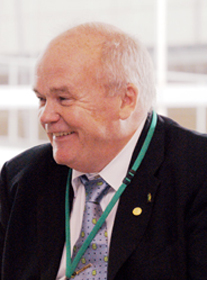 I think that the concept of the “Nature’s Wisdom,” which is the theme of EXPO 2005 is very attractive. But how should we consider nature?
I think that the concept of the “Nature’s Wisdom,” which is the theme of EXPO 2005 is very attractive. But how should we consider nature?